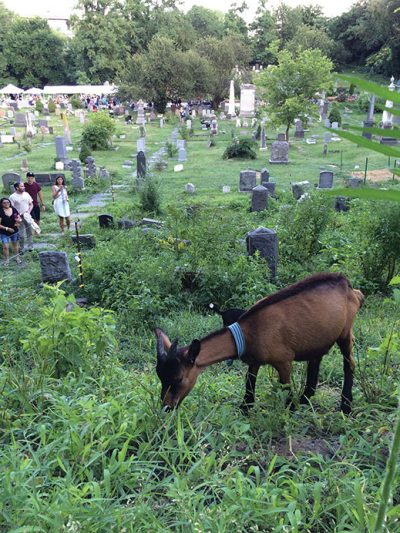
“Growing up, Sundays were about church, jelly donuts and visiting the cemetery,” says Eileen Markenstein, sharing her memories of the Historic Jersey City and Harsimus Cemetery. The tradition stayed with her through adulthood until one Sunday in May 2007, when she and other visitors arrived to find the gates bolted shut.
The scurrilous caretaker, who for years had been embezzling money and selling phony plots to unsuspecting families, had taken the money and run, literally tossing history aside in the process. “He would gather up centuries of tombstones,” says Markenstein, “and throw them behind the shed, and resell plots and write up phony deeds, which families paid for in cash.”
Four generations of the Markenstein family are buried in the cemetery alongside prominent local leaders and thousands of soldiers from as far back as the Revolutionary War. Before becoming an official cemetery in 1829, the 6-acre site was a bloody encampment site where General Marquis de Lafayette and 4,000 of his men joined forces with George Washington’s troops in Revolutionary War skirmishes against the British. During the War of 1812, the land served as a lookout point and was the site of an ammunition bunker, still visible today.
By the time the gates were padlocked in 2007, the cemetery had descended into squalor. The caretaker’s home was occupied by squatters and junkies. Weeds towered over visitors, making it all but impossible to locate family burial sites.
In 2008, the state turned over the cemetery keys to Markenstein, now 57 and a resident of Union City. A new board of trustees was established; Markenstein—who retired as executive fiduciary director at Morgan Stanley—was named president. The painstaking work of restoring the cemetery began. Over the years, Markenstein and her army of volunteers have lifted and re-grounded more than 370 monuments and tombstones.
The volunteers include veterans like John, who served in Grenada, and Tommy, who was a POW during the Vietnam War. Former roommates in a rooming house in downtown Jersey City, they were left homeless after their landlord upped the rent. Now the two tend to the cemetery and live rent free in the caretaker’s residence. They welcome visitors seven days a week from 8:30 am until sundown.
Volunteer gardeners meticulously care for the cemetery’s grounds, which are home to more than 65 species of plants and bushes and host a menagerie of visiting wildlife, including deer, cats, groundhogs, foxes, hawks, falcons, turtles and one directionally challenged rooster.
The newest flock of creatures to inhabit the grounds is perhaps the most useful. For the second year running, a group of goats from a farm in upstate New York arrived this spring to live and work at the cemetery. “They eat up invasive weeds like poison ivy and Japanese knotwood,” says Markenstein. “We don’t use chemicals because this is such a sanctuary for wildlife and Eco culture. And, of course, they are such a big hit with visitors.”
With no regular funding, the cemetery (435 Newark Avenue) depends on volunteers, donations and fundraisers. It also presents plays, concerts and an annual Earth Day celebration. Master gardeners from Rutgers University work with volunteers to run an urban farming workshop for city youth. On Memorial Day and Veterans Day, gatherers pay tribute to the nation’s veterans. In time, the board hopes to achieve National Historic Landmark Preservation status.
